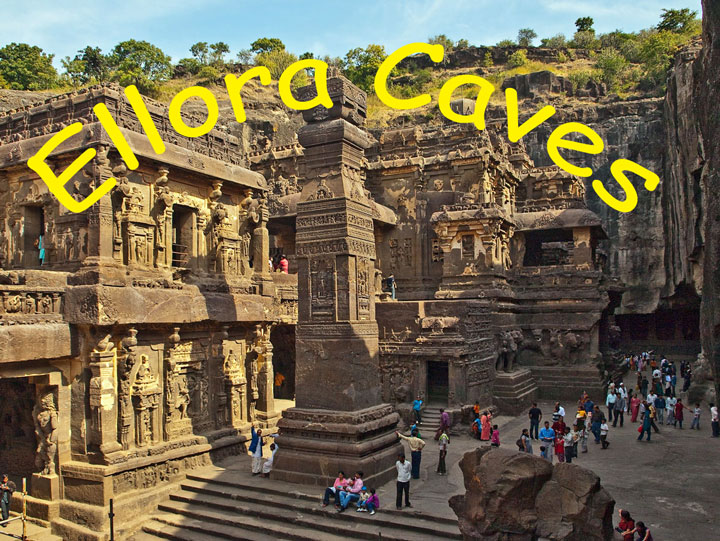 ELLORA The Incredible Caves The ancient Indian name for Ellora was Verul Leni. Even now the local people refer to this place as Verul. It is one of the largest rock-cut cave complexes in the world. These temples and caves were carved out of the vertical face of the Charanandri Hills from the 6th to the 10th centuries. They are dedicated to the various gods of Hinduism, Buddhism and Jainism, thus showing the great religious tolerance which was prevalent in India at that time long before the advent of Islam and Christianity. This used to be an important commercial centre of the Deccan region since it was located on the ancient trade route from South Asia. Initially the caves served as monasteries for monks and places for pilgrims to rest. Though I had heard so much about these caves my main reason for going there was to have darshana of Lord Shiva in the famous temple of Grishneswara. There are 12 jyotirlingas or temples which are especially dedicated to Lord Shiva in India. I had already visited 11 of them. This was my twelfth and last so I was most eager to make a visit there. The fact that it was in the village of Verul or Ellora was only an additional advantage as far as I was concerned. However it was only after I reached the place that I realised that Shiva had a special treat in store for me. He was going to take me to one of his most fabulous abodes. As we entered the garden around the caves, we were naturally led to cave no. 16, the Kailasa temple.  This fantastic temple had been carved from the top of the mountain to the bottom, slowly unfolding the form of the temple while descending. It’s a vertical excavation. This means that the mountain was cut from the top and excavated downwards. The normal way to make a temple out of a huge rock face is to carve the facade and then slowly go backwards. But this monolith, made out of one single block of rock more than two thousand years ago, defied this method and did just the opposite! This type of work requires a mind-boggling amount of pre-planning and mathematical and engineering genius which we cannot even imagine. On top of this we have to believe that this was built by hand using only a pick axe for digging and of course other types of rough tools for chiselling etc! The plan of the temple was such. The temple was in the middle with a space running round it and a corridor encircling it. It has two huge flagstaffs on either side and two bridges connecting the corridor with the temple. All this was made out of the same rock. Nothing was brought from outside and no pieces were cemented. 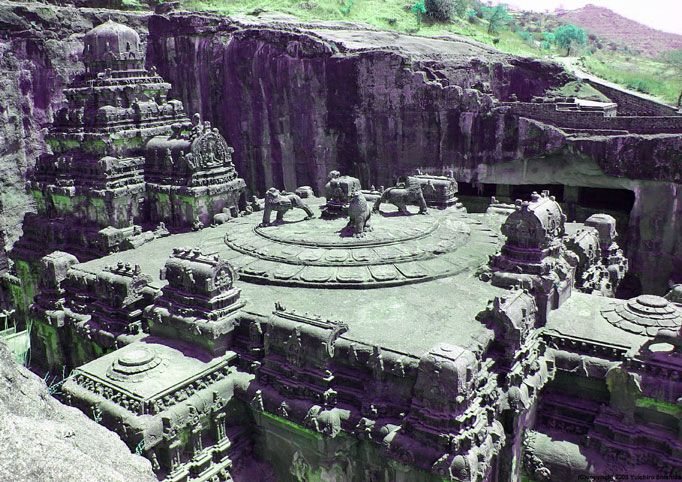 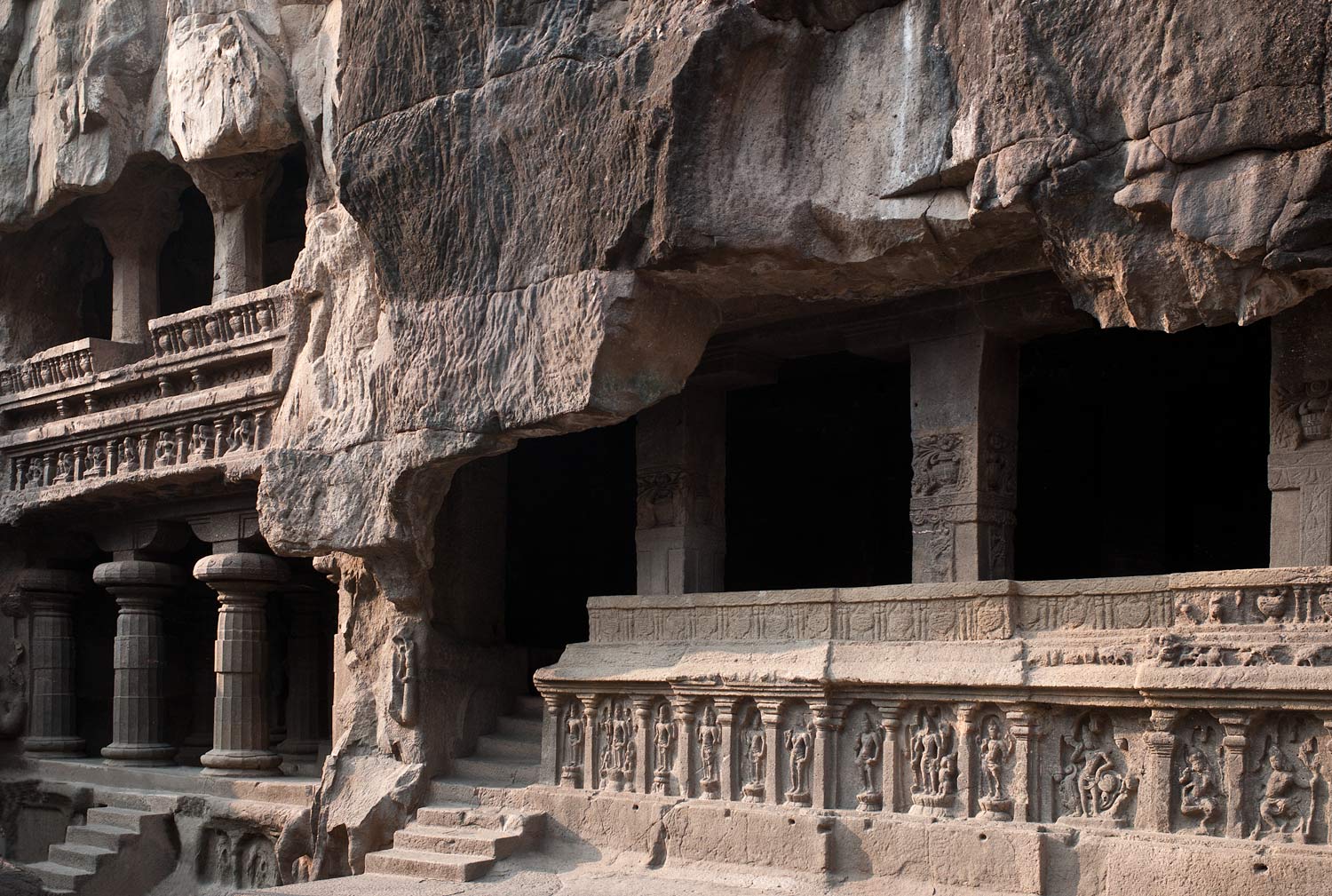 Interestingly there is ancient Marathi legend which gives the reason for such a unique architectural approach. The local king suffered from a debilitating disease. His queen prayed to Grishneswar (Shiva) at the local temple to cure her husband. She vowed to construct a temple if her wish was granted and promised to fast until she could see the Shikhara (top point) of the temple. The king was cured and she requested him to start the building immediately but all the architects declared that it would take months and even years to build a temple complete with the Shikhara. Obviously the queen would die of starvation before she saw it. Only one architect called Kokasa assured the king that the queen would be able to see the Shikhara of the temple in a week’s time. Hence he started building the temple from the top. In this way he was just about able to finish the Shikhara in a week’s time, thus enabling the queen to break her fast. The temple was named Manikeshwara after the queen. It has been proved that Kokasa was indeed the chief architect of the Kailasa temple as it later came to be called. It is indeed a feat of human genius. Apparently it entailed the removal of 25,000 tons of rock and must have taken 100 years to complete though legend says it was completed in 19 days. The area is double that of the Parthenon. 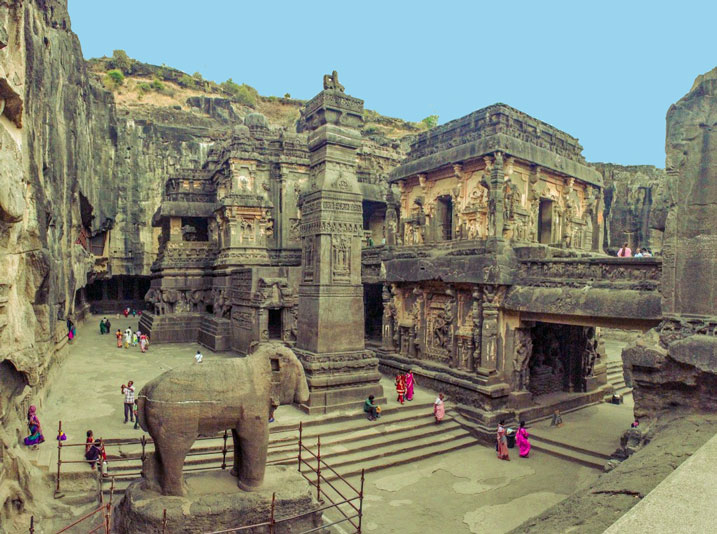 Another incredible thing about this temple is that it defies all attempts to destroy it. It has stood unshaken through the different invasions and wars which has taken place in the country. Many Muslim rulers like Aurangzeb tried his best to destroy the temple completely. He ordered one thousand men to work night and day and completely raze the structure to the ground. They labored night and day for over three years but were totally unable to bring the temple down. All they could do was to disfigure some of the magnificent sculptures. Another Muslim tried to do the same with the Egyptian pyramids but was forced to admit defeat since they could not be broken down. What sort of spell did these ancients put on their structures which prevented them from being totally demolished? There are indeed many mysteries connected with this temple. 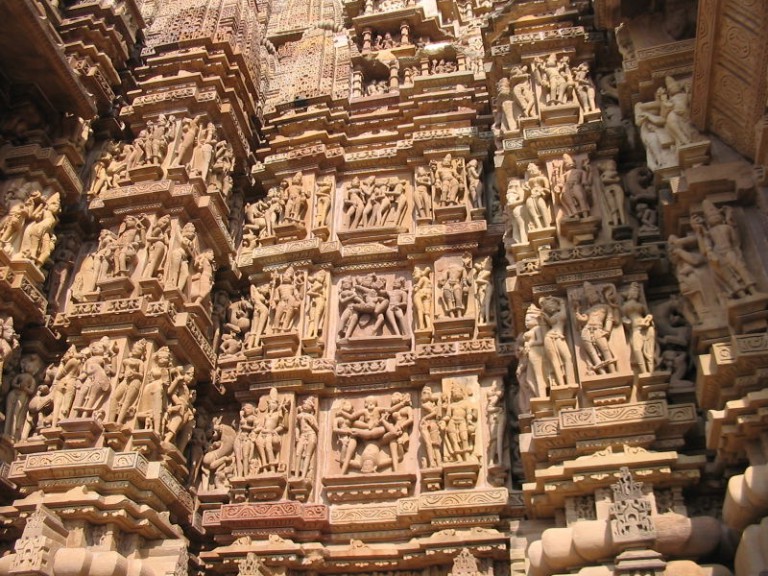 I gasped when we actually entered the courtyard which runs round three sides. The temple stands above this courtyard which is decorated with colossal elephants and other animals. The sanctum is on a plinth and has a flight of steps leading to it. It is a doubled storey building with chapels and halls hewn out of the rock. The Shikara which must have been carved out first, rises in three tiers with a projecting gable surmounted by a cupola. The dwajasthambhas or flag staffs on either side are huge pillars with fantastic carvings. When we think that these must also have been hewn out of the same rock and worked downwards we can’t help but gasp in wonder. Of course the modern mind balks at believing that our ancestors could have risen to such heights of engineering and architectural perfection without the aid of modern instruments and hence there is a theory that this was a creation of beings from outer space and that it must have been created by extra terrestrials. And that is why this is the only temple in the whole complex which can be seen from the sky perhaps from a space ship!! I feel that this statement is an insult to the great craftsmen of India. The people who say this have no concept of the greatness of our ancient rishis who have created such marvels of construction that will put all our modern architects, along with their fantastic equipments to shame. 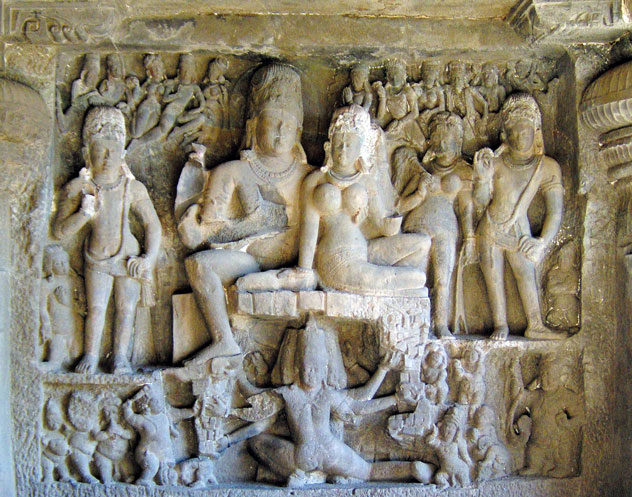 Let us have a look at some of the other Shiva temples in India which give us the same feeling of awe. Who were these great beings who conceived and executed these great temples? 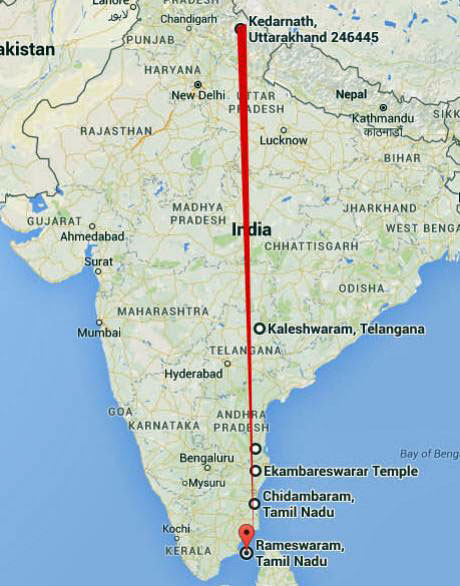  Miraculous Appearance of Phoenix in Deepam Shiva Festival Jyoti, Thiruvanamalai Shiva also has five temples in which he is represented as one of the five classical elements- Earth, Water, Fire, Air and Space. The water element is seen in the temple at Thirvanaikaval where the linga (phallic symbol of Shiva) has a continuous stream of water coming from under it, the element of fire is seen in Thiruvanamalai where the whole hill has a huge bonfire once a year, the temple for Air is in Sri Kalahasti. It is a huge temple and in order to get to the sanctum sanctorum one has to walk through miles of corridors. But still you find that the flame of the lamp inside the sanctum is constantly flickering as if from a gust of air! The temple for earth is Ekambareshwaram in Kanchipuram where again you find that at the base of the lingam there is always a lot of earth which can never be completely cleaned out. The temple for space is Chidambaram in which there is no lingam at all, only space. These are all built in a certain geographic alignment which we are still unable to gauge and unable to understand how they did it. Chidambaram, Sri Kalahasti and Ekambareswara temples are located in a straight line at 79 degrees and 41 minutes. Of the other two temples, Thiruvanaikkaval is located 3 degrees south and exactly 1 degree to the west of the northern tip of this divine axis while Thiruvannamalai is midway – 1.5 degrees to the south and 0.5 degrees to the west. All these facts can be verified on a Google map. Surely we cannot attribute all these miraculous creations to some alien who came from outer space? As far as Indians are concerned these mysteries were all possible to our ancient sages who worked on a plane totally different from ours. We are all five-sensory beings but they were multi- sensory beings. They used 100% of their brain whereas we use less than 10%. Just because we are unable to understand their towering personalities, bordering on the super human, it does not mean that they did not exist. These great beings trod this holy land of India in ancient times. Chidambaram is another example which shows the great knowledge the rishis had about astronomy, astrology and geometry. 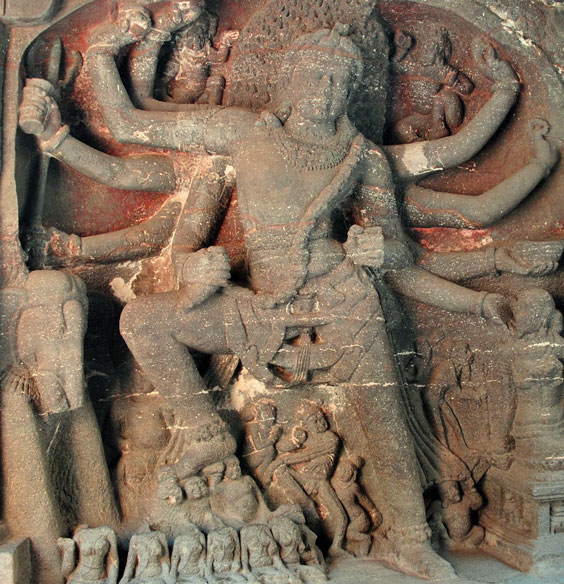 Shiva As Nataraji Lord Of The Dance The architecture of the temple of Shiva at Chidambaram is based on the human body thus showing their knowledge of anatomy!! It has nine entrances corresponding to the nine orifices of our body. The roof is made of 21,600 gold sheets which denote the 21,600 breaths taken by the human being in one day. These gold sheets are fixed to the gopuram or Shikara, using 72,000 gold nails which denote the total number of nadis or nerves in the human body. The nadis transfer energy to those body parts which are invisible. The temple is tilted slightly towards the right to give place for our heart which is to the left of the lungs. There are five steps leading to the sanctum which represent the five syllables of the great mantra of Shiva – na-ma-shi-va-ya. The four pillars holding up the hall represent the four Vedas. The golden temple has twenty-eight pillars which denote the 28 methods of worshipping Shiva. These pillars support the 64 beams of the roof representing the 64 arts. The cross beams represent the blood vessels running through the human body. The nine pots on top of the golden roof represent the 9 types of shaktis or energies. The eighteen pillars in the adjacent hall represent the eighteen Puranas. The dance of Shiva as Nataraja as seen in the temple denotes the cosmic dance of energy of the protons and neutrons! If our ancients could have taken all these things into consideration when constructing this temple why should be doubt their ability to construct a huge monolith like the Kailasa temple in Ellora? 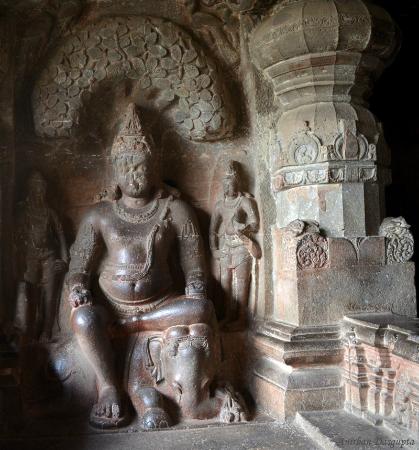 After having seen the Kailasa temple, the rest of the caves pale into insignificance. However many of them do have some interesting points. The 17 Hindu caves are arranged to the North of the Kailasa temple. They represent an entirely different style from the Buddhist caves since they were all carved from the top to the bottom. It is probable that they took many generations to complete. Even though most of the caves are dedicated to Shiva, there are still some figures of Vishnu and other gods. Even the Kailasa temple has beautiful figures of Hindu gods. I got a lovely shot of Narasimha. Cave 15 is known as the Dasavatara cave since the top floor depicts all the ten avataras or incarnations of Vishnu. The cave also has a beautiful sculpture of Shiva as Nataraja, the cosmic dancer. Cave 21 is known as Rameswara and is said to be the oldest of the Hindu caves. It has some very good statues of river goddesses and amorous couples. Cave 25 has a sculpture of the sun god Surya driving his chariot towards dawn. Cave 29 has pairs of lions guarding its three staircases. To the left of the entrance Shiva defeats Ravana’s attempt to shake Kailasa. At the side there is a cute little figure of a dwarf who is baring his bottom to mock at the rakshasa. There is another beautiful one of Shiva teasing Parvati by holding back her arm as she prepares to throw the dice in the game they are obviously playing.   The upper storey is borne on 12 profusely sculptured pillars and these and the broad surface dividing the two storeys are copiously carved, the upper one having images of the 24 Jain tirthankaras. The ceiling over the large altar is in the form of a large lotus. At each end of the hall is a big shrine containing a statue of Mahavira. This temple is possibly the earliest of the Jain group. The Jagannatha Sabha has a beautifully carved statue of Mahavira. On the top of the hill in which the Jain caves are excavated is a rock-hewn statue of Parsanath, another avatara of Mahavira. This was the last of the Ellora caves. As we came out my mind was seething with a hundred visions. I was wafted to that ancient times when the workers were hewing down the rocks and I could stand at the edge and watch them perform this remarkable feat. My head was buzzing with a thousand questions and my mind with a thousand impressions. I had to return to the hotel to sit down quietly and try to take in this amazing sight we had been fortunate enough to see. Hari Aum Tat Sat
|